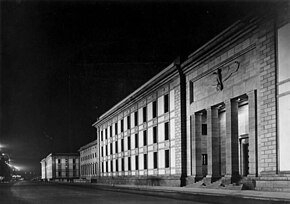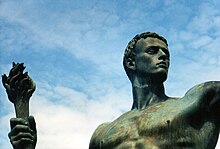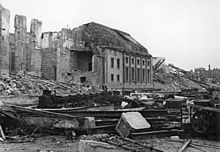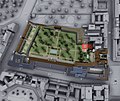New Reich Chancellery

The New Reich Chancellery in Berlin's Vossstraße was built between 1934 (start of planning) and 1943 (cessation of construction) under Adolf Hitler according to plans by Albert Speer as a supplement to the old Reich Chancellery and the extension built in 1928–1930 in Wilhelmstraße . She is a perpetrator place .
Building history
On January 11, 1938, Hitler officially commissioned General Building Inspector Albert Speer with a new building along the entire Vossstrasse, which corresponds to a building front of 421 meters in length. The planning had already started in 1934, and from 1935 the 18 buildings on the street were bought up piece by piece. The Palais Borsig ( Vossstraße 1 ), which has also been in the hands of the Reich since 1934 , was not demolished but integrated into the new building. The construction plans were realized by Hans Peter Klinke .
By contrast, the buildings on Vossstrasse 2-10 were demolished by 1937. This also included the Bavarian embassy ( house number 3 ), the Ministry of Justice ( house number 4/5 ) and the Württemberg embassy ( house number 10 ). Only with the official award of the building contract to Albert Speer did the demolition of the buildings west of it, Vossstrasse 11-19 (including the Gauleitung Greater Berlin of the NSDAP and the Saxon Legation) begin.
From the beginning of 1938, the completion of the New Reich Chancellery was worked on at full speed, so that it could be completed in time for the annual diplomatic reception on January 7, 1939. This did not succeed; some expansion work lasted until the early 1940s. The description given by Speer in his autobiography after the Second World War that he was asked to see the “ Führer ” at the end of January 1938 and that he had completely surprisingly told him that Speer should design a New Reich Chancellery for him cannot otherwise be proven.
The construction of the Führerbunker , which was not included in the original plans, did not begin until 1943. It was not located under the New Reich Chancellery, but together with other air raid shelters used by Hitler in the garden of the Old Reich Chancellery (Wilhelmstrasse 77). The New Reich Chancellery also received air raid shelter in 1938; these were used by people from the area.
Overall, the construction of the Reich Chancellery cost 90 million Reichsmarks , which, adjusted for purchasing power, corresponds to around 388.3 million euros in today's currency.
Hitler's architecture and study
When designing the New Reich Chancellery, Speer was mainly concerned with the architectural representation of the power and glory of the Fuhrer and the Reich. With the famous "Diplomatic Route" he created a magnificent and elongated 300-meter-long room suite: from the monumental "Ehrenhof", via a vestibule to the "Mosaic Hall", the "Round Hall", the "Marble Gallery" ending in the "Reception Hall" or in the “Führer’s study”. This architectural concept was based on the baroque enfilade , the representative path leading through lavishly furnished rooms to the absolute ruler. Speer and Hitler wanted to surpass the baroque display of splendor. The “marble gallery” was twice as long as the Hall of Mirrors at Versailles . The New Reich Chancellery was intended to impressively underpin the claim to German dominance in Europe. Architect Caesar Pinnau was responsible for the interior design of several offices, the Fuehrer's office and the large conference room .
Hitler's study was the largest and most magnificent room in the building. It had a footprint of almost 400 m² and was almost ten meters high. Noble materials were used: dark red Saalburg marble , rosewood and rosewood for the walls, rosewood for the coffered ceiling and Ruhpolding stone slabs for the floor. The generously dimensioned desk was decorated with inlays and the top was covered with red leather. The card table had a one-piece marble slab five meters long and 1.60 meters wide. Valuable paintings in splendid frames in accordance with Hitler's taste in art hung on the walls. Hitler used this office mainly for representation purposes.
Furnishing
To design the new Reich Chancellery, von Speer brought in numerous artists and craftsmen on behalf of Hitler. The furniture in the headquarters of power was made by hand especially for this building. This also applied to silver cutlery and tableware, tapestries and curtains.

Among the leading sculptors involved were
- Arno Breker (sculptures on the central main portal Die Party [Torch Bearer] and The Wehrmacht [Sword Bearer]),
- Josef Thorak (larger than life bronze horses on the terrace facing the park) and
- Kurt Schmid-Ehmen (national emblem: imperial eagle with swastika ).
The building technology corresponded to the most modern standard at the time and included, among other things, air conditioning and escalators in the office wing.
Remnants of the furnishings can be found today in the German Historical Museum in Berlin (desk and globe from Hitler's study), in the Kremlin in Moscow (chandelier and candelabra), in the Pentagon in Washington (paintings), in the Museum of European Art in Nörvenich Castle (the Sculpture The Party ) and as loot and souvenir in the possession of former Allied soldiers and their heirs as well as private collectors (furniture, dishes).
Speer decorated the garden behind the main building with large bronze figures, including two ostentatious statues by Josef Thorak . One of the bronze horses was last seen on a barracks area of the Russian armed forces in Eberswalde . Their whereabouts after the withdrawal of the Soviet armed forces from Germany in the 1990s was unclear until 2015, before the two “Striding Horses” were found on May 20, 2015 in a nationwide raid in Bad Dürkheim . A monumental granite relief by Arno Breker was discovered in a warehouse, which was probably intended for the triumphal arch that was not realized.
destruction
During the air raids on Berlin , the New Reich Chancellery was only slightly damaged until the end of the war. After the conquest of Berlin , the Soviet troops captured one of the imperial eagles (bronze work by Kurt Schmid-Ehmen ) from the imperial chancellery. The Soviet Union transferred it to Great Britain in 1946 . Today it is on display in the Imperial War Museum in London (see picture below).
As one of the central symbols of Hitler's power, the complex of buildings of the New and Old Reich Chancellery and the Borsig Palace , which had been destroyed to varying degrees, was demolished from 1949 to 1956 on the orders of the Soviet Control Commission .
Since after 1945 Saalburg marble (a red limestone and in the petrographic sense not real marble ) was used for representative buildings in the GDR , it was rumored that the floor and wall coverings of the New Reich Chancellery, some of which also consisted of this material, were being used again . This applies to the foyers of the Humboldt University and the Old Palace , the Mohrenstraße underground station and the Soviet memorials (in Treptower Park , in the Tiergarten and in Schönholzer Heide ). There is no direct evidence of this.
In Roberto Rossellini's film Germany in the year zero from 1947, several scenes take place in the ruins of the New Reich Chancellery. This shows that the floor coverings in the area of the marble gallery have already been removed in sections.
During the foundation preparations for new buildings on the corner of Voss and Ebertstraße , fragments of former window frames or eaves were recovered in February 2008 . The stones could be assigned to the New Reich Chancellery.
Today a plaque from the Topography of Terror Foundation commemorates the building. The building site was rebuilt with multi-storey prefabricated apartments in the late GDR period around 1988 .
- Pictures of the Reich Chancellery
Original bronze imperial eagle from the New Reich Chancellery
literature
- Albert Speer. Architecture. Works 1933–1942. Propylaen-Verlag, Berlin 1978 (unabridged reprint. Ibid 1995, ISBN 3-549-05446-7 ).
- Dietmar Arnold : Reich Chancellery and "Führerbunker". Legends and Reality. Links, Berlin 2005, ISBN 3-86153-353-7 .
- Dieter Bartetzko : Illusions in Stone. Mood architecture in German fascism. Your background in theater and film buildings. Rowohlt, Reinbek near Hamburg 1985, ISBN 3-499-17889-3 (rororo non-fiction book 7889. Cultures and ideas) .
- Dieter Bartetzko: Between discipline and ecstasy. On the theatrics of Nazi architecture. Mann, Berlin 1985, ISBN 3-7861-1420-X (Gebr.-Mann-Studio series) .
- Olaf Groehler : The New Reich Chancellery. The end. Brandenburgisches Verlags-Haus, Berlin 1995, ISBN 3-89488-087-2 (The European Diary. 1945) .
- Andreas Grüner: From Didyma to the Reich Chancellery. An icon of National Socialism and its Hellenistic model. In: Pegasus. 6, 2004, ISSN 1436-3461 , pp. 133-148, bbaw.de (PDF; 26.42 MB).
- Alexander Kropp: The Political Significance of the NS Representation Architecture. Albert Speer's redesign plans for the conversion of Berlin into the “World Capital Germania” 1936–1942 / 43. ars una Verlagsgesellschaft, Munich (inter alia) 2005, ISBN 3-89391-135-9 ( Deutsche Hochschuledition 135).
- Christoph Neubauer: City guide through Hitler's Berlin - then & now. Christoph Neubauer Verlag, Frankfurt (Oder) 2019, ISBN 978-3-9813977-2-7 .
- Ronald Pawly: Hitler's Chancellery. (A Palace to Last a Thousand Years.) Crowood Press, Ramsbury 2009, ISBN 978-1-84797-091-6 .
- Frank-Bertolt Raith: The Heroic Style. Studies on architecture at the end of the Weimar Republic. Verlag für Bauwesen, Berlin 1997, ISBN 3-345-00606-5 .
- Angela Schönberger : Albert Speer's new Reich Chancellery. On the connection between National Socialist ideology and architecture. Gebr. Mann, Berlin 1981, ISBN 3-7861-1263-0 ( Gebr. Mann Studio series) (Also: Berlin, Free University, dissertation 1978).
- Alexander Scobie: Hitler's state architecture. The impact of classical antiquity. Pennsylvania State University Press, University Park PA (et al.) 1990, ISBN 0-271-00691-9 ( Monographs on the Fine Arts 45).
- Chronicle for the imperial capital Berlin . In: Berliner Adreßbuch , 1939, before part 1; IV. Construction, p. 12 (description of the construction work on the New Reich Chancellery).
- Andreas Nachama (Ed.): Wilhelmstrasse 1933–1945 - Rise and Fall of the Nazi Government Quarter, Topography of Terror Foundation, 2012, ISBN 978-3-941772-10-6 , pp. 54 ff.
- Ernst Günther Schenck : The emergency hospital under the Reich Chancellery - A doctor experiences Hitler's end in Berlin , VMA-Verlag, Wiesbaden 2000.
Films (selection)
- The downfall . Feature film, Germany, 2004, TV version: 178 min, theatrical version: 155 min, script: Bernd Eichinger , director: Oliver Hirschbiegel .
- Mysterious places - Hitler's Reich Chancellery. Documentary, Germany, 2012, 43:42 min, script and direction: Jürgen Ast and Kerstin Mauersberger, production: astfilm, rbb , series: Mysterious Places , first broadcast :, October 22, 2012 by Das Erste , summary by rbb, u. a. with the computer graphic artist Christoph Neubauer, the architectural historian Wolfgang Schächen , the art historian Angela Schönberger and the urban planner Dieter Hoffmann-Axthelm .
Web links
- The New Reich Chancellery - Shoa.de history portal
- Site of Hitler's Bunker and New Reich Chancellery. In: Traces of Evil, 2009, (English)
Individual evidence
- ↑ Jan Heidtmann : botched buildings like BER Berlin: “Germanias” demon . In: Süddeutsche.de , January 20, 2013.
- ↑ The amount was determined with the template: Inflation and relates to last January.
- ^ NDR: Busy and controversial: Architect Caesar Pinnau. Retrieved February 9, 2020 .
- ↑ Florian Müller-Klug: Hitler's Offices in Berlin - Part 1: The Reich Chancellery and the New Reich Chancellery . In: Clio Berlin Blog , November 14, 2014.
- ^ Ernst-Adolf Chantelau: The bronze statues of Tuaillon, Thorak, Klimsch and Ambrosi for Hitler's garden . A contribution to the topography of the New Reich Chancellery by Albert Speer. Books on Demand , Norderstedt 2019, ISBN 978-3-7494-9036-3 .
- ↑ Film diary “Time of the Gods”, 1988–1994 ( Memento of the original from March 13, 2012 in the Internet Archive ) Info: The archive link was inserted automatically and has not yet been checked. Please check the original and archive link according to the instructions and then remove this notice. (PDF; 203 kB)
- ↑ dpa : Striding horses. Lost Nazi art discovered . In: faz.net from May 20, 2015.
- ↑ dpa: Bad Dürkheim. Monumental Nazi art from Berlin discovered in Bad Dürkheim . In: Die Rheinpfalz , May 20, 2015.
- ↑ Bernd Kleinhans: The "New Reich Chancellery" (2007)
- ↑ Johannes H. Schroeder: Natural stone works in architecture and building history of Berlin / Guide to Geology in Berlin and Brandenburg No. 6. Self-published Geoscientists in Berlin and Brandenburg e. V., Berlin 1999, ISBN 3-928651-07-2 .
Coordinates: 52 ° 30 ′ 41 ″ N , 13 ° 22 ′ 49 ″ E



















